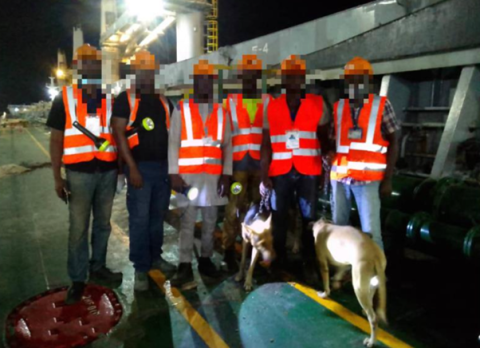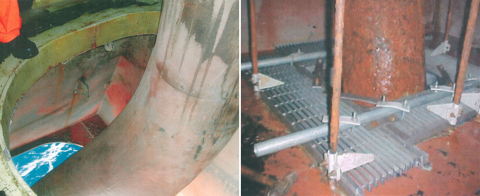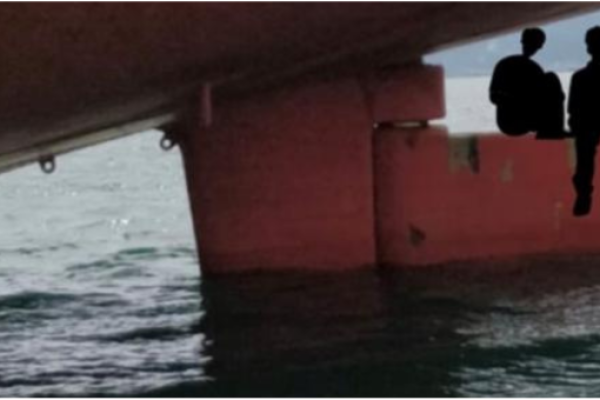
Steamship Mutual
Published: August 02, 2023
IMO definition of Stowaway
The Convention on Facilitation of International Maritime Traffic, 1965, as amended, (The FAL Convention), defines a stowaway as "A person who is secreted on a ship, or in cargo which is subsequently loaded on the ship, without the consent of the shipowner or the Master or any other responsible person and who is detected on board the ship after it has departed from a port, or in the cargo while unloading it in the port of arrival, and is reported as a stowaway by the master to the appropriate authorities.”
Background
Stowaway cases can be protracted and complicated, having commercial implications for the shipowners / operators and presenting operational challenges for the ship’s crew. Stowaways can pose significant issues for the Members, with the potential for disruption to the vessel’s schedule.
The IMO has published “Consideration and analysis of reports and information on persons rescued at sea and stowaways” which analyses claims data collated by the International Group of P&I Clubs on stowaway cases, in order to facilitate the discussions on stowaways at the IMO level.
Stowaways take great risks with their lives, and their determination and resourcefulness to succeed in pursuing their goals of a different life should never be underestimated. There have been a number of recorded instances where stowaways are known to have used threatening behaviour toward the ship’s crew. Some countries are reluctant to assist the Master with disembarkation of stowaways at their ports, consequently stowaways may be required to remain on the ship until an alternative, suitable port of disembarkation can be identified by the shipowners. Some local State authorities may have their own specific escorting requirements for the stowaways and these local authorities may require the ship to remain in port until such time as the stowaways have left their jurisdictions.
It is important that, prior to arrival in an area susceptible to stowaways, Member vessel’s undertake vulnerability and risk assessments and verify that the ship security plan includes adequate hardening measures to prevent and deter access to the vessel by potential stowaways. Robust, well developed procedures, together with a well-trained crew are two of the many key factors that need to be considered when combatting the issue of stowaways. The use of conventional methods of prevention, such as razor wire, together with newer technological solutions such as strict access control, swift communication system and CCTV should all be considered as a means of deterring stowaways.
This Risk Alert is intended to provide guidance to prevent stowaways gaining access to the vessel, and on the subsequent actions to be taken should stowaways be successful in boarding the vessel.
Preventative Measures
The Master is responsible for the safety of everyone on board, including stowaways, should they be successful in gaining access to the vessel, rendering the Owner liable for all related costs that may be incurred which can include the provision of local guards to prevent unauthorised landing of stowaways and any secure shoreside accommodation and onward repatriation that the local authorities may require. Members are reminded to consult with the Club’s local correspondents on the potential for stowaway issues and to review and act upon any pertinent information that may be issued by local authorities. Implementation of preventative measures should be exercised well in advance of the vessel’s arrival in a vulnerable region. In some instances, Port States may impose heavy fines on a vessel basis there being stowaways on board of a vessel within their jurisdiction.
General guidance to safeguard against stowaways gaining access to a vessel
Implementation of the following measures should be considered to mitigate against the likelihood of stowaways getting access to a vessel –
- Prior to arrival in port gather local information, warnings and statistics from local agents with regard to the risk of stowaways;
- In some ports in South Africa and South America for example the contracting of dog search teams is a consideration and some of these companies provide limited indemnity language within their contract / T&C to address instances where a stowaway is found after a search. An example of the type of indemnity being offered may be a waiver of the fees and a limited contribution of compensation to cover stowaway repatriation;
- Security level in line with ISPS requirements, taking appropriate preventive measures and notifying concerned parties;
- Prior to port entry, ensure all doors and hatchways are securely fastened, locked and sealed;
- Accommodation superstructure access limited to one or two doors. All other accesses to be secured from the inside using suitable means to permit opening from inside in the event of an emergency;
- Lockers, stores and entrances not required for accommodation access or cargo operations should be kept locked;
- Vent trunkings and other void spaces to be made inaccessible through the use of wire mesh, grills, steel bars welded/fitted across the entrance or other appropriate means;
- Hawse pipe covers to be fitted and secured at all times when the anchor cable is not being heaved or paid out. If no hawse pipe covers fitted anchor wash should be left running to prevent/discourage persons climbing the anchor cable;
- Install suitable grating or other means to prevent access from a rudder compartment.


- At anchor –
- Enhanced lookout capability and vigilant radar watch to ensure early detection of any approaching small vessels;
- Pilot ladders / accommodation ladders to be recovered and stowed after use, they must not be left unattended when rigged;
- Frequent deck patrol watch to be maintained, ensuring close communication with the bridge at all times;
- 24/7 accommodation ladder / gangway security watch whilst alongside, ensure no unauthorised access;
- Where possible, practicable accommodation ladder / gangway to be lifted clear of the quay to prevent unauthorised boarding;
- Where appropriate, available, and as may be required by local authorities, employ local security watchmen to supplement vessel’s crew;
- Frequent and unscheduled deck patrols by the ship’s crew whilst alongside.
- Vigilant and alert ship’s crew are an important factor in deterring potential stowaways;
- Floodlights to illuminate all areas and surroundings of the vessel so that approach of any unauthorised boats can be detected as early as possible;
- List of anticipated visitors to be provided in advance of vessel’s arrival at any port;
- Visitors to have ISPS clearance and photographic identification;
- Visitors to surrender port entry permit/identification card to ship’s security upon boarding and collect same when leaving the ship;
- Where visitors do not have a port permit, the terminal/berth security must be contacted immediately to verify identity of the individual who should be held at entry/access pending clearance;
- Stowaways may attempt to gain access disguised as stevedores, it is important therefore that stevedores have valid visible ID on them;
- All activities to be properly recorded in vessel’s logbooks.
- SMS procedures available for conducting a stowaway search, upon completion of cargo operations, prior to departure and for logging details of the search.
- On completion of loading a cargo compartment, the space to be diligently searched and, upon completion of search, the compartment is to be sealed and locked:
- Fumigation or sealing of cargo holds and spaces to be carried out only after a thorough stowaway search has been completed, ensuring that no stowaways are present within those compartment;
- Upon completion of cargo operations, and following the disembarkation of all shore-based personnel, a further stowaway search should be undertaken. The ship's crew should be split into multiple teams, depending on the number of crew available, and each party led by a responsible officer who has knowledge of and familiar with the search area.
- The stowaways search should be co-ordinated to ideally search all areas of the ship including safety equipment/compartments (lifeboats etc), simultaneously to provide a greater level of assurance that there are no stowaways onboard. As each compartment is searched it must be re-secured, and the keys delivered to the Master.
- In high risk ports, upon departure and having released the tugs and pilot, consideration should be given to anchoring outside the port for a final stowaway search including the rudder trunk. It should then be possible for stowaways found in this final search to be discharged directly to the shore authorities, thus potentially minimising costs that might be otherwise incurred if stowaways were to be discovered later in the voyage.
- Stowaways might try to gain access to vessels whilst underway via small boats, and this should be a consideration if a stoppage upon departure, for a final stowaway search, is initiated. Previously highlighted measures to be undertaken when at anchor should be implemented.
Container ships face a potential problem where deficient port security may encourage stowaways to enter containers which may not then be searched after loading due to the sheer numbers, lack of access and/or available manpower. Prevention becomes more problematic and only forward planning and improved port security can hope to discourage the determined illegal immigrant or smuggler.
Actions Taken when the stowaway is detected and found onboard
Once a sea passage commences the master is limited in their ability to deviate from the intended voyage. Should a vessel identify the presence of a stowaway the Master should immediately bring this to the attention of the Owners and other concerned stakeholders, the Club should be consulted at the earliest opportunity. The presence of a stowaway should be recorded in the appropriate logbooks and the following should be considered in line with best practice and pertinent SMS procedures –
- A thorough ship search to verify that no additional stowaways are hidden on the vessel;
- Question stowaways at the first opportunity of being found and endeavour to establish their identity;
- Try to establish the stowaway port of embarkation;
- Carry out search for any documents stowaway may be carrying;
- Take statements from stowaway(s) and also any crew witnessing the stowaway arrest;
- Prepare the master’s statement which will be required for notification of appropriate authorities such as Flag State, shipowner, Charterers, Port authorities of embarkation (if known / applicable) and Port authorities of proposed port of disembarkation, and if required subsequent port of calls. An example reporting form can be found in the Appendix to the IMO Resolution FAL.13(42);
- Ensure that the applicable documentation is completed in a timely manner prior to arrival at the intended port of stowaway disembarkation and that it is presented to the appropriate authorities;
- Ensure that at all times any stowaway is well cared for onboard the vessel until the time of their being handed over to the concerns authorities, and that their safety and security are maintained;
- Any stowaway is to be treated humanely and must not be made to work onboard the vessel except in the event of an emergency situation;
- The safety and security of the crew is to be maintained throughout the period when a stowaway is onboard;
- A stowaway should ideally be locked/confined to an empty cabin with toilet/shower facilities;
- The cabin doors and port holes should be supplemented with a fabricated steel bar door and padlock facility for ensuring security.
- The doors are to be guarded continuously by the ship’s crew, and the condition of the stowaway to be checked and recorded frequently to ensure their wellbeing;
- At times stowaways can become aggressive and should at all times be treated with extreme caution. In such cases the meals should be served through the steel bars with the door kept locked at all times.
- Sharp objects such as glass/mirror/metal which can be used by the stowaway to harm themselves or the crew and need to be removed prior the stowaway being confined to the cabin. The meals to be served in paper plates/cups and with soft plastic utensils for the above reason if possible.
- Most importantly, any stowaway is to be included in the emergency muster list so as not to be overlooked in the event of an emergency;
Members are encouraged to bring this Risk Alert and IMO Revised Guidelines to the attention of their masters and other staff to remind them of the risk of stowaways and of the appropriate and reasonable precautions that can be taken to prevent stowaways gaining access to their vessels.
https://wwwcdn.imo.org/localresources/en/OurWork/Facilitation/Documents/FAL%2043-13.pdf
A Club Circular on preventive measures recommended for vessels calling at Dakar, Senegal is available at this link.
For further information please contact the Loss Prevention Department
Steamship Insurance Management Services Ltd. Tel: +44 20 7247 5490
Risk Alert 99


